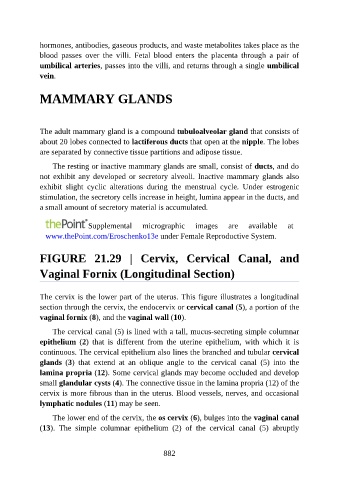Page 883 - Atlas of Histology with Functional Correlations
P. 883
hormones, antibodies, gaseous products, and waste metabolites takes place as the
blood passes over the villi. Fetal blood enters the placenta through a pair of
umbilical arteries, passes into the villi, and returns through a single umbilical
vein.
MAMMARY GLANDS
The adult mammary gland is a compound tubuloalveolar gland that consists of
about 20 lobes connected to lactiferous ducts that open at the nipple. The lobes
are separated by connective tissue partitions and adipose tissue.
The resting or inactive mammary glands are small, consist of ducts, and do
not exhibit any developed or secretory alveoli. Inactive mammary glands also
exhibit slight cyclic alterations during the menstrual cycle. Under estrogenic
stimulation, the secretory cells increase in height, lumina appear in the ducts, and
a small amount of secretory material is accumulated.
Supplemental micrographic images are available at
www.thePoint.com/Eroschenko13e under Female Reproductive System.
FIGURE 21.29 | Cervix, Cervical Canal, and
Vaginal Fornix (Longitudinal Section)
The cervix is the lower part of the uterus. This figure illustrates a longitudinal
section through the cervix, the endocervix or cervical canal (5), a portion of the
vaginal fornix (8), and the vaginal wall (10).
The cervical canal (5) is lined with a tall, mucus-secreting simple columnar
epithelium (2) that is different from the uterine epithelium, with which it is
continuous. The cervical epithelium also lines the branched and tubular cervical
glands (3) that extend at an oblique angle to the cervical canal (5) into the
lamina propria (12). Some cervical glands may become occluded and develop
small glandular cysts (4). The connective tissue in the lamina propria (12) of the
cervix is more fibrous than in the uterus. Blood vessels, nerves, and occasional
lymphatic nodules (11) may be seen.
The lower end of the cervix, the os cervix (6), bulges into the vaginal canal
(13). The simple columnar epithelium (2) of the cervical canal (5) abruptly
882

